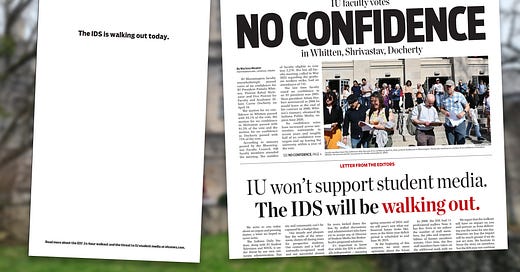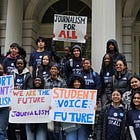Indiana Daily Student strikes over budget strain
The Scarlet & Black at Iowa's Grinnell fights cut with community backing

Amid campus turmoil, The Indiana Daily Student journalists made a strategic move last Thursday: They ceased operations for 24 hours.
With an approximate $900,000 deficit, it was a move to give the Indiana University Bloomington community a “glimpse of a possible future without the IDS as it exists today.”
Editors-in-Chief Salomé Cloteaux and Nic Napier said they hoped this would prompt a concrete, sustainable financial plan for student media from the administration.
Otherwise, they said the paper may have to shut down after years of financial hardships.
“We needed to take action because we cannot lose anything more,” Cloteaux said. “It was a terrifying decision because the IDS has never walked out in its 157-year history. But we have to do it.”
During the 24-hour work stoppage, no stories were published on the website.
The paper’s weekly print edition was still distributed, but with an almost empty front page bearing the text: “The IDS is walking out today.”
It still reported on a pro-Palestinian demonstration that began that day on X — as it promised to report on any “urgent” breaking news during the walkout.
“It’s supposed to be very symbolic in nature, but also realistic, in a sense if we lose the print,” Napier said. “We’re just trying to show how important student media is and get the community involved in this conversation.”
What’s happening at Indiana’s flagship university highlighted a shared struggle among student publications nationwide, including one in rural Iowa where student journalists mobilized community support to fight funding threats.
Mike Hiestand, a senior legal counsel at the Student Press Law Center, said while news outlets have faced financial setbacks since the COVID-19 pandemic, student media have enjoyed some buffer.
But he said they are beginning to feel the effects, with many publications transitioning entirely online — a concerning trend.
“There is a bit of once out of sight, they’re out of mind,” Hiestand said. “And they just kind of lost a lot of their relevance on some campuses.”
At IU, the Media School’s Student Media Committee has been exploring ways to sustain student outlets. One proposal suggested merging all outlets to streamline operations.
The IDS’ financial challenges have persisted for years. In 2021, the paper was running out of money but was allowed to run a deficit under the school until the end of June this year.
Efforts to establish a new business model were underway even before that.
The IDS relies on advertising and donations, totaling around $600,000 a year. Some financial decisions still require university approval — as do 56.1% of student newspapers nationwide.
Jim Rodenbush, director of student media at IU, said salaries for full-time professional advisors and printing bills represent the two largest regular expenses. He said student workers are paid at various rates based on their roles.
“I can't be anything but proud and appreciative of the kind of response that our financial situation has produced from both the students and from the outside community,” Rodenbush said, noting the walkout was an “unusual stance.”

‘Save The Print’ mobilizes community
Facing a similar potential cut, The Scarlet & Black at Grinnell College, located about 55 miles east of Des Moines, Iowa, rallied community support to secure a voice at the negotiating table.
Recently informed that the college's proposed budget wouldn’t support its print production, the newspaper, alongside six other student publications, faced financial uncertainty.
The news prompted the team to explore funding alternatives like running advertising and organizing a fundraiser — options hindered by the university’s bureaucratic processes, according to the paper.
“I think the biggest thing is that every step along the way, we don’t really know what’s happening in its entirety,” said Nick El Hajj, an editor-in-chief. “We were left out of our budget conversations.”
That's when they sought support from those who rely on the newspaper most.
The S&B put together a special edition, “Save The Print,” which features voices of support from Grinnell residents, professional journalists, current students and journalism educators.
Last week, the student journalists were invited to sit in during the budget process — a result El Hajj found “inspiring.”
Co-Editor-in-Chief Eleanor Corbin attributed this progress to the “Save The Print” initiative and the pressure exerted by supporters on the student affairs office.
“It really shows that if we hadn’t gotten all these publications together, really made a fuss about the idea that we wouldn’t accept this allocation of our budget, I don’t think it would have happened,” Corbin said.
A pattern
Baldwin Wallace University: Facing more than $20 million in deficit, the Ohio university considered cutting the budget for The Exponent’s print product.
Pennsylvania State University: The Daily Collegian will lose all of its funding from the university starting the next fiscal year.
Southeastern Louisiana University: Half of the university’s $12 student publication fee, around $150,000, was shifted to fund new positions in the Title IX office in 2021. The Lion Roar moved its production completely online.
Utah Tech University: Sun News Daily faced a 25% budget reduction in 2019 to cut down “the excess printing of newspapers that go unread.”
💸 Facing a cut? Here’s some advice
From the students: Do what’s necessary for your publication. If the university’s giving you an answer that doesn’t make sense, push back on it. While you don’t generally want to become a news story, sometimes you have to if your paper is in jeopardy. Don’t be afraid to use your voice.
Cut as a censorship tool: This is illegal. If you can show that connection, there are laws that support you, according to Hiestand. Reach out to First Amendment or student media advocacy groups.
Other reasons: Challenges arise when administrations justify cuts with declining readership and interest, Hiestand said. In this case, it’s harder to find a legal framework, leaving student media in a precarious position.
Playbook: The SPLC developed a College Media Survival Guideline to detail strategies and questions to ask during your budgeting process.
Story Spotlight:
🪧 It was quite a week for student journalists. I wanted to spotlight multiple student outlets that have been covering developments around pro-Palestinian encampments on college campuses. Their coverage is better than ones by professional journalists parachuting in when it comes to sourcing and nuances.
WKCR, the radio station at Columbia University, broadcasted this nonstop for more than a week since the April 18 mass arrests. They said public safety tried to “force” them off the air during the first weekend. Also, shoutout to The Columbia Spectator.
👀 The Yale Daily News, The Daily Texan, The Berkeley Beacon, The Michigan Daily, The Minnesota Daily, The Daily Trojan, The Diamondback, The GW Hatchet, The Campus Times, The Niner Times, The Pitt News, The Washington Square News, The New School Free Press and many more provided incredible coverage of protests on their campuses following the fallout at Columbia.
🚨 If you’re covering a protest, the SPLC has tips about your rights and how to stay safe while doing so. I’m rooting for you!
Featured Opportunities:
Washington State University has openings for two entry-level journalism fellowships at KHQ/KNDU and The Spokesman-Review/Spokane Public Radio.
Her Campus reviews remote internship applications on a rolling basis. The deadline for the summer is April 30 and Aug. 16 for the fall.
Medium is looking for fellows with knowledge of US elections and politics, world politics and programming/tech for its curation team. Apply before April 30.
Thrill Mag, one of Gen-Z’s most-read worldwide publications, is seeking remote interns for multiple roles. Apply before May 5.
The CPB is hiring an external affairs intern in D.C. with a May 6 deadline.
314 in Focus is hosting a youth-focused journalism conference “314 Media Day” in St. Louis, Missouri, May 21.
The National Press Foundation is accepting applications for its 2024 Elections Journalism Fellowship, which will run July 28-30 in Detroit. Apply before May 27.
The 19th is seeking fellows for a year for reporting, audience engagement, product and technology roles. Apply before May 31.
I want to hear from you: How did your publication navigate through budget cuts? How do you build community support for what you’re doing? Is your student publication doing something cool that you’d like to share? Reach me at nutgrafnews@substack.com. I will respond! Also, please share.







